Reviewed by Glenn Erickson
Mario Bava fans rejoice -- we now have a very good Blu-ray recording of Bava's horror / Sci-fi hybrid Planet of the Vampires in Region A. Scorpion Releasing has also found some interesting extras for the disc, and has wisely engaged Video Watchdog publisher Tim Lucas to provide a commentary. As one might expect, Bava's prime biographer delivers dozens of new or thoughtful facts about the film.
Planet of the Vampires may be the Bava movie with the most special effects, although his fanciful lighting style is so diverting that it can be fairly considered a special effect on its own. Most every shot applies the in-the-camera trick film techniques that made him the go-to guy for fantastic visuals in '50s Italian cinema. Some call Planet a Gothic Sci-fi, what with the resurrected astronaut corpses being identified as vampires in the English-language version. In 1965, with the Italo horror cycle on the wane, an alien planet inhabited by undead spirits was a novel idea.
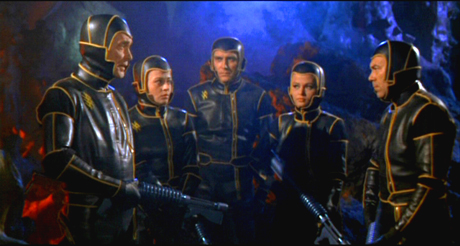
Twin spaceships Argos and Galliot alight on the volcanic and foggy planet Aura, and the nightmare begins. Captain Mark Markary (Barry Sullivan) and Sanya (Norma Bengell) of the Argos can barely restrain members of the crew from maiming each other in inexplicable fits of violence. Worse, when they investigate the Galliot's radio silence, they discover its entire crew is dead, with evidence pointing to an orgy of killing. While the Argos is being repaired some crewmembers report seeing strange lights. Mark and Sanya investigate a derelict alien craft nearby. It is littered with the skeletal remains of grotesque alien creatures. When the space travelers' hastily buried casualties begin returning from their graves, a terrible secret finally becomes obvious: spectral beings on Aura can mentally control their fellow spacemen, and possess their dead bodies.
Had it been released a couple of years later, the near-psychedelic Planet of the Vampires might have become a noted 'trip' film -- its atmosphere of colored smoke, weird lighting and the strange costumes were farther 'out there' than anything yet on the screen. We are told that Bava could toss off these delicate visual effects and complex lighting schemes at a dizzying pace. Bava's main achievement is the creation of a fantastic, dreamlike atmosphere. This is not the outer space of Stanley Kubrick. The spaceships could belong to Buck Rogers, and the planet Aura could be a mythic Hell from Bava's Hercules in the Haunted World. Yet even Bava booster Tim Lucas sometimes feels the need to qualifiy the film's visual accomplishments in terms of screen realism, reminding us that the miniatures and planet-scapes are effective considering that they were concocted from next to nothing. He's certainly not complaining, and we agree that the superior Planet of the Vampires needs no excuses. Good visuals make for good cinema.
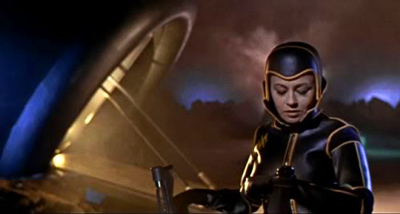
Science fiction movies are the only genre in which success was routinely measured by the realism of the special effects. Most of us biased against giant space ships that look like toys, yet readily accept them in Japanese fantasies. I still don't feel hypercritical when pointing out that Bava's planetary vistas often have a sharp foreground and background, but a fuzzy mid-ground, the photographic impossibility that unmasks many faked flying saucer photos. But Planet also features shots so well accomplished that they don't yield to easy analysis. When the film was new we certainly didn't realize that Bava had filmed some spaceship shots underwater. Tim Lucas's explanations for other Bava effects point out things I had never considered (including an errant finger caught holding a miniature).
And who wants realism, anyway? The alien phantasmagoria of Bava's one Sci-fi film is more interesting than the Death Valley scenery and fake studio caves of Robinson Crusoe on Mars. Bava approached his films as personal art craft. He kept them small-scale so as to not lose this artistic control. In the middle '60s, before the visual effects boom, this made Bava a one-man effects artisan-genius on the order of Ray Harryhausen. Nobody confuses the animation of Harryhausen with that of anyone else, and the same goes for Bava. We know a Bava picture as soon as we see the way scenes are lit. As Tim Lucas points out, even a simple insert of a hand picking up an object is immediately recognizable as Bava's. Nobody else sculpted such attractive blends of color and shadow.
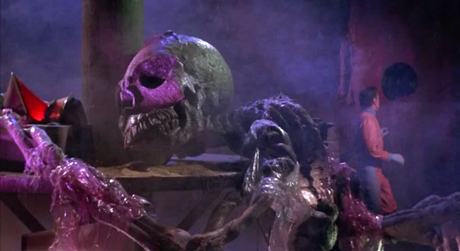
Planet of the Vampires does have drawbacks, in that its story simplifications (for budgetary purposes?) perhaps go too far. The Argos was meant to land intact and the Galliott was to be wrecked, but it was too tempting to keep both spaceships in good repair so that one set could serve for both. One must pay close attention to know which ship one is in at any particular time. Both the ship interior and the smoking, foggy landscape outside are largely assembled from modular units -- sliding doors and blank wall panels inside, interchangeable rocks outside. We never get a good idea of the geography of either area, which maybe dreamlike but also creates a feeling of spatial disconnection.
Barry Sullivan's captain and to a lesser extent Norma Bengell's assistant stay clear in our heads, but despite their distinctive appearances the other astronauts are mostly interchangeable. There's a lack of variety in what the characters to do, which causes us to lose track of them as well. The astronauts fight, shoot ray guns, and run from one place to another incessantly -- I'm normally a detail freak for space pictures but I must admit that I've never been able to pay full attention to the story details.
Bava also skims over the finer points of the script, in favor of his more cinematic visual flourishes. The film's most novel idea is its 'peripheral vision' Auran phantoms, which the spacemen can only glimpse out of the corners of their eyes. But Bava offers no visual representation of this beyond flashing some lights across the frame. I can imagine considering an "Aura-Vision" effect in which something can be seen only in the corners of the frame -- just where the average projection set-up would mask it away.
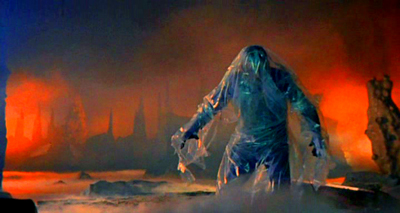
These 'dreamlike' details contribute to Planet of the Vampires status as a movie that's barely a narrative experience. We instead soak up the heady Auran atmosphere of pure visual delirium. The famed rising of the 'Vampires' from their impromptu crypts is certainly eerie, despite the slow motion achieved with optical step printing. Did A.I.P. impose that? We know that Bava avoided optical work whenever possible.
Finally we have the film's defining sequence, the investigation of the derelict alien spacecraft with the giant skeletons that look like spiders with human skulls. Even the sound effects add to this scene, as Captain Markary and Sanya work to free themselves before an ancient mechanism pumps all of the oxygen from the ship interior. Back in 1965 we assumed that the skeleton was the remains of an Auran. Only after Ridley Scott's Alien came out did we pay attention to the dialogue in these scenes. Tim Lucas notes the interesting fact that the skeletons outside of the wrecked ship are posed much like the dead human bodies found back in the Galliot - the Aurans's forced both races to destroy themselves using mental control. A more focused screenplay would have Sanya or Markary pointing out this similarity for the benefit of clueless thirteen year-olds in the audience (me). Not since Forbidden Planet were we invited to contemplate an alien race based on archeological evidence. Planet of the Vampires succeeds as a spacey spook show, but it also touches on some very good ideas.

The Kino Lorber Blu-ray of Planet of the Vampires is a pleasing HD transfer with excellent color. The release far, far outclasses MGM's Midnite Movies DVD of late 2001, which had good color but was not widescreen-enhanced. The refurbished encoding is the American cut with English dialogue only, the track that was supervised and partially re-written by writer-director Ib Melchoir. The extras, produced by Scorpion Releasing, include an original trailer, a still gallery and a licensed "Trailers from Hell" segment with a mini-commentary by Joe Dante. The opening title sequence from the Italian version is included as well, along with samples of the replacement music tracks added by Orion in the 1980s. In space, nobody can hear Kendall Schmidt!
For Sci-fi addicts, Scorpion has also encoded an English translation of the entire text of Renato Pestriniero's source story "One Night of 21 Hours".
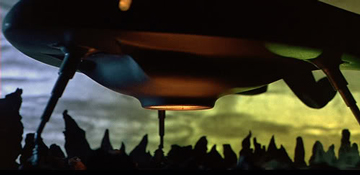
Tim Lucas's full-length commentary is packed with facts about the production gleaned from his own researches and (with full acknowledgement) those of author-researchers Tom Weaver and Robert Skotak. 1 Lucas' interpretations of the film's effects scenes are particularly illuminating, especially when he describes the low-tech methods by which things like instrument panel view screens were accomplished. How did Bava put together his crazy Auran landscapes for no money? Literally smoke and mirrors, and Lucas even names the two kinds of smoke that were used. Lucas also admits that he has not quite figured out a thing or two, such as why a character is played by one actor early in the film and another actor later on. I would guess it was a flub in the English dialogue script, as Lucas probably has a better handle on the film's characters than did the dubbing supervisor Melchoir. 2 I particularly enjoy hearing Tim calmly explain the film's umpteen title changes, one version after another. Lucas mentions Orion Pictures, but I wish he had talked a bit about MGM's restoration department, which since the middle '90s has been restoring cut scenes and original music tracks to many of our favorite American-International fantasy and horror films.
Mario Bava's films are slowly but surely arriving on Blu-ray, and labels like Scorpion are stepping up to the plate with splendid new HD transfers. Good versions of Blood and Black Lace, The Whip and the Body and Danger: Diabolik are dream titles for the Blu-ray future.
On a scale of Excellent, Good, Fair, and Poor,
Planet of the Vampires Blu-ray rates:
Movie: Good, for fantasy film fans Excellent
Video: Excellent
Sound: Excellent
Supplements:
Deaf and Hearing Impaired Friendly?
N0; Subtitles: None
Packaging: Keep case
Reviewed: October 4, 2014
Footnote:
1. Robert Skotak's account of the filming of Planet of the Vampires is still a great read:
Ib Melchoir, Man of Imagination by Robert Skotak. 2000, Midnight Marquee, Baltimore.
Return
2. 11.05.14: I wrote, "I would guess it was a flub in the English dialogue script?" Unwise words from a less casual reviewer than Tim Lucas, who must have been circling overhead as I posted the review. In his response Tim straightens out my error and offers more thoughts on actors playing musical chairs in movies:
Hi, Glenn -- In your very good and very kind review of my contribution to the POTV disc, you write "Lucas also admits that he has not quite figured out a thing or two, such as why a character is played by one actor early in the film and another actor later on. I would guess it was a flub in the English dialogue script, as Lucas probably has a better handle on the film's characters than did the dubbing supervisor Melchoir. "
This was no dubbing flub as, in the shot of the two possessed astronauts being found and invited aboard the Argos, we literally see the first actor walk toward the camera into shadows and then be replaced by the second actor, Massimo Righi, in the next shot! I point this out as it happens in the commentary, but I guess you missed it. Incidentally, I have since identified the actor who played Doctor Sallis in the early part of the picture as Peter Martell, whose biggest success appears to have been in Italian Westerns, but he also made War of the Planets with Margheriti the same year as POTV. I can't think of another example of a single character being played by two different actors in a movie because the first actor left the production, or whatever. * Neither Martell nor Righi worked with Bava ever again, and I imagine there's an interesting story there. I should ask Lamberto about it.
This is just speculation, but perhaps because the film ran overtime in the search for a lead actress, Martell had committed to another job and had to leave. Indeed, if he left to make a space picture with Margheriti, it's possible that this was the basis of the enmity between Bava and Margheriti I heard about from a few interviewees.
Glad you liked the disc! It's a beauty. Cheers, Tim
* Glenn: Hey, in all humility, I just happened to think of one: Paul Birch in Not of this Earth.
Return

Text © Copyright 2014 Glenn Erickson
See more exclusive reviews on the Savant Main Page.
Reviews on the Savant main site have additional credits information and are often updated and annotated with reader input and graphics.
T'was Ever Thus.
Return to Top of Page
|

